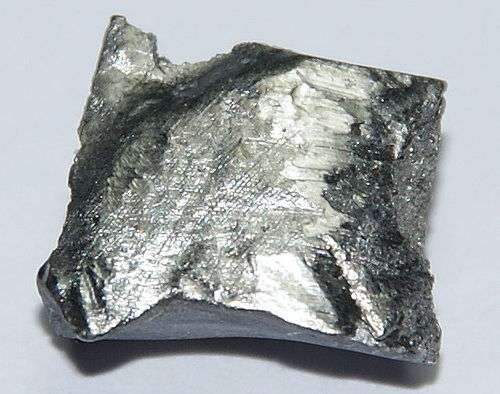 | ||||||||||||||||||||||||||||
| Terbium | ||||||||||||||||||||||||||||
|---|---|---|---|---|---|---|---|---|---|---|---|---|---|---|---|---|---|---|---|---|---|---|---|---|---|---|---|---|
| Pronunciation | /ˈtɜːrbiəm/ | |||||||||||||||||||||||||||
| Appearance | silvery white | |||||||||||||||||||||||||||
| Standard atomic weight Ar°(Tb) | ||||||||||||||||||||||||||||
| Terbium in the periodic table | ||||||||||||||||||||||||||||
| ||||||||||||||||||||||||||||
| Atomic number (Z) | 65 | |||||||||||||||||||||||||||
| Group | f-block groups (no number) | |||||||||||||||||||||||||||
| Period | period 6 | |||||||||||||||||||||||||||
| Block | f-block | |||||||||||||||||||||||||||
| Electron configuration | [Xe] 4f9 6s2 | |||||||||||||||||||||||||||
| Electrons per shell | 2, 8, 18, 27, 8, 2 | |||||||||||||||||||||||||||
| Physical properties | ||||||||||||||||||||||||||||
| Phase at STP | solid | |||||||||||||||||||||||||||
| Melting point | 1629 K (1356 °C, 2473 °F) | |||||||||||||||||||||||||||
| Boiling point | 3396 K (3123 °C, 5653 °F) | |||||||||||||||||||||||||||
| Density (at 20° C) | 8.229 g/cm3 [3] | |||||||||||||||||||||||||||
| when liquid (at m.p.) | 7.65 g/cm3 | |||||||||||||||||||||||||||
| Heat of fusion | 10.15 kJ/mol | |||||||||||||||||||||||||||
| Heat of vaporization | 391 kJ/mol | |||||||||||||||||||||||||||
| Molar heat capacity | 28.91 J/(mol·K) | |||||||||||||||||||||||||||
Vapor pressure
| ||||||||||||||||||||||||||||
| Atomic properties | ||||||||||||||||||||||||||||
| Oxidation states | 0,[4] +1,[5] +2, +3, +4 (a weakly basic oxide) | |||||||||||||||||||||||||||
| Electronegativity | Pauling scale: 1.2 (?) | |||||||||||||||||||||||||||
| Ionization energies |
| |||||||||||||||||||||||||||
| Atomic radius | empirical: 177 pm | |||||||||||||||||||||||||||
| Covalent radius | 194±5 pm | |||||||||||||||||||||||||||
| Other properties | ||||||||||||||||||||||||||||
| Natural occurrence | primordial | |||||||||||||||||||||||||||
| Crystal structure | hexagonal close-packed (hcp) (hP2) | |||||||||||||||||||||||||||
| Lattice constants | c = 569.66 pm (at 20 °C)[3] | |||||||||||||||||||||||||||
| Thermal expansion | at r.t. poly: 10.3 µm/(m⋅K) | |||||||||||||||||||||||||||
| Thermal conductivity | 11.1 W/(m⋅K) | |||||||||||||||||||||||||||
| Electrical resistivity | α, poly: 1.150 µΩ⋅m (at r.t.) | |||||||||||||||||||||||||||
| Magnetic ordering | paramagnetic at 300 K | |||||||||||||||||||||||||||
| Molar magnetic susceptibility | +146000×10−6 cm3/mol (273 K)[6] | |||||||||||||||||||||||||||
| Young's modulus | 55.7 GPa | |||||||||||||||||||||||||||
| Shear modulus | 22.1 GPa | |||||||||||||||||||||||||||
| Bulk modulus | 38.7 GPa | |||||||||||||||||||||||||||
| Speed of sound thin rod | 2620 m/s (at 20 °C) | |||||||||||||||||||||||||||
| Poisson ratio | 0.261 | |||||||||||||||||||||||||||
| Vickers hardness | 450–865 MPa | |||||||||||||||||||||||||||
| Brinell hardness | 675–1200 MPa | |||||||||||||||||||||||||||
| CAS Number | 7440-27-9 | |||||||||||||||||||||||||||
| History | ||||||||||||||||||||||||||||
| Naming | after Ytterby (Sweden), where it was mined | |||||||||||||||||||||||||||
| Discovery and first isolation | Carl Gustaf Mosander (1843) | |||||||||||||||||||||||||||
| Isotopes of terbium | ||||||||||||||||||||||||||||
| ||||||||||||||||||||||||||||
Terbium is a chemical element; it has the symbol Tb and atomic number 65. It is a silvery-white, rare earth metal that is malleable and ductile. The ninth member of the lanthanide series, terbium is a fairly electropositive metal that reacts with water, evolving hydrogen gas. Terbium is never found in nature as a free element, but it is contained in many minerals, including cerite, gadolinite, monazite, xenotime and euxenite.
Swedish chemist Carl Gustaf Mosander discovered terbium as a chemical element in 1843. He detected it as an impurity in yttrium oxide, Y2O3. Yttrium and terbium, as well as erbium and ytterbium, are named after the village of Ytterby in Sweden. Terbium was not isolated in pure form until the advent of ion exchange techniques.
Terbium is used to dope calcium fluoride, calcium tungstate and strontium molybdate in solid-state devices, and as a crystal stabilizer of fuel cells that operate at elevated temperatures. As a component of Terfenol-D (an alloy that expands and contracts when exposed to magnetic fields more than any other alloy), terbium is of use in actuators, in naval sonar systems and in sensors. Terbium is considered non-hazardous, though its biological role and toxicity has not been researched in depth.
Most of the world's terbium supply is used in green phosphors. Terbium oxide is used in fluorescent lamps and television and monitor cathode-ray tubes (CRTs). Terbium green phosphors are combined with divalent europium blue phosphors and trivalent europium red phosphors to provide trichromatic lighting technology, a high-efficiency white light used for standard illumination in indoor lighting.
Characteristics
Physical properties
Terbium is a silvery-white rare earth metal that is malleable, ductile and soft enough to be cut with a knife.[8] It is relatively stable in air compared to the more reactive lanthanides in the first half of the lanthanide series.[9] Terbium exists in two crystal allotropes with a transformation temperature of 1289 °C between them.[8] The 65 electrons of a terbium atom are arranged in the electron configuration [Xe]4f96s2. The eleven 4f and 6s electrons are valence. Only three electrons can be removed before the nuclear charge becomes too great to allow further ionization, but in the case of terbium, the stability of the half-filled [Xe]4f7 configuration allows further ionization of a fourth electron in the presence of very strong oxidizing agents such as fluorine gas.[8]
The terbium(III) cation is brilliantly fluorescent, in a bright lemon-yellow color that is the result of a strong green emission line in combination with other lines in the orange and red. The yttrofluorite variety of the mineral fluorite owes its creamy-yellow fluorescence in part to terbium. Terbium easily oxidizes, and is therefore used in its elemental form specifically for research. Single terbium atoms have been isolated by implanting them into fullerene molecules. Trivalent Eu3+ and Tb3+ ions are among the lanthanide ions that have garnered the most attention because of their strong luminosity and great color purity.[10][11]
Terbium has a simple ferromagnetic ordering at temperatures below 219 K. Above 219 K, it turns into a helical antiferromagnetic state in which all of the atomic moments in a particular basal plane layer are parallel and oriented at a fixed angle to the moments of adjacent layers. This antiferromagnetism transforms into a disordered paramagnetic state at 230 K.[12]
Chemical properties
Terbium metal is an electropositive element and oxidizes in the presence of most acids (such as sulfuric acid), all of the halogens, and water.[13]
- 2 Tb (s) + 3 H2SO4 → 2 Tb3+ + 3 SO2−4 + 3 H2↑
- 2 Tb + 3 X2 → 2 TbX3 (X = F, Cl, Br, I)
- 2 Tb (s) + 6 H2O → 2 Tb(OH)3 + 3 H2↑
Terbium oxidizes readily in air to form a mixed terbium(III,IV) oxide:[13]
- 8 Tb + 7 O2 → 2 Tb4O7
The most common oxidation state of terbium is +3 (trivalent), such as in TbCl
3. In the solid state, tetravalent terbium is also known, in compounds such as TbO2 and TbF4.[14] In solution, terbium typically forms trivalent species, but can be oxidized to the tetravalent state with ozone in highly basic aqueous conditions.[15]
The coordination and organometallic chemistry of terbium is similar to other lanthanides. In aqueous conditions, terbium can be coordinated by nine water molecules, which are arranged in a tricapped trigonal prismatic molecular geometry. Complexes of terbium with lower coordination number are also known, typically with bulky ligands like bis(trimethyl-silylamide), which forms the three-coordinate Tb[N(SiMe3)2]3 complex.
Most coordination and organometallic complexes contain terbium in the trivalent oxidation state. Divalent (Tb2+) complexes are also known, usually with bulky cyclopentadienyl-type ligands.[16][17][18] A few coordination compounds containing terbium in its tetravalent state are also known.[19][20][21]
Oxidation states
Like most rare-earth elements and lanthanides, terbium is usually found in the +3 oxidation state. Like cerium and praseodymium, terbium can also form a +4 oxidation state,[22] although it is unstable in water.[23] It is possible for terbium to be found in the 0,[24][25] +1,[26] and +2[22] oxidation states.
Compounds
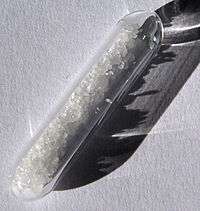
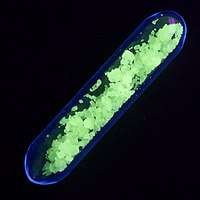
Terbium combines with nitrogen, carbon, sulfur, phosphorus, boron, selenium, silicon and arsenic at elevated temperatures, forming various binary compounds such as TbH2, TbH3, TbB2, Tb2S3, TbSe, TbTe and TbN.[27] In these compounds, Tb mainly exhibits the oxidation state +3, with the +2 state appearing rarely. Terbium(II) halides are obtained by annealing Tb(III) halides in presence of metallic Tb in tantalum containers. Terbium also forms the sesquichloride Tb2Cl3, which can be further reduced to TbCl by annealing at 800 °C; this compound, terbium(I) chloride, forms platelets with layered graphite-like structure.[28]
Terbium(IV) fluoride is the only halide that tetravalent terbium can form. It has strong oxidizing properties and is a strong fluorinating agent, emitting relatively pure atomic fluorine when heated, rather than the mixture of fluoride vapors emitted from cobalt(III) fluoride or cerium(IV) fluoride.[29] It can be obtained by reacting terbium(III) chloride or terbium(III) fluoride with fluorine gas at 320 °C:[30]
- 2 TbF3 + F2 → 2 TbF4
When TbF4 and CsF is mixed in a stoichiometric ratio in a fluorine gas atmosphere, CsTbF5 is obtained. It is an orthorhombic crystal with space group Cmca and a layered structure composed of [TbF8]4− and 11-coordinated Cs+.[31] The compound BaTbF6, an orthorhombic crystal with space group Cmma, can be prepared in a similar method. The compound [TbF8]4− also exists.[32]
Other compounds include:
- Chlorides: TbCl3
- Bromides: TbBr3
- Iodides: TbI3
- Fluorides: TbF3, TbF4
Isotopes
Naturally occurring terbium is composed of its only stable isotope, terbium-159; the element is thus mononuclidic and monoisotopic.[33] Thirty-nine radioisotopes have been characterized,[34] with the heaviest being terbium-174 and lightest being terbium-135 (both with unknown exact mass).[7] The most stable synthetic radioisotopes of terbium are terbium-158, with a half-life of 180 years, and terbium-157, with a half-life of 71 years. All of the remaining radioactive isotopes have half-lives that are less than three months, and the majority of these have half-lives that are less than half a minute.[7] The primary decay mode before the most abundant stable isotope, 159Tb, is electron capture, which results in production of gadolinium isotopes, and the primary mode after is beta minus decay, resulting in dysprosium isotopes.[7]
The element also has 31 nuclear isomers, with masses of 141–154, 156, 158, 162, and 164–168 (not every mass number corresponds to only one isomer).[34] The most stable of them are terbium-156m, with a half-life of 24.4 hours, and terbium-156m2, with a half-life of 22.7 hours; this is longer than half-lives of most ground states of radioactive terbium isotopes, except those with mass numbers 155–161.[7]
Terbium-149, with a half-life of 4.1 hours, is a promising candidate in targeted alpha therapy and positron emission tomography.[35][36]
History
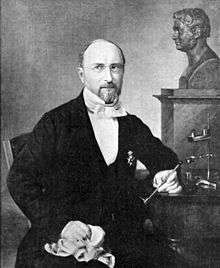
Swedish chemist Carl Gustaf Mosander discovered terbium in 1843.[37][38] He detected it as an impurity in yttrium oxide, Y2O3, then known as yttria. Yttrium, erbium, and terbium are all named after the village of Ytterby in Sweden.[39][40] Terbium was not isolated in pure form until the advent of ion exchange techniques.[41]
Mosander first separated yttria into three fractions, all named for the ore: yttria, erbia, and terbia. "Terbia" was originally the fraction that contained the pink color, due to the element now known as erbium. "Erbia", the oxide containing what is now known as terbium, originally was the fraction that was yellow or dark orange in solution.[37][39] The insoluble oxide of this element was noted to be tinged brown,[42][43] and soluble oxides after combustion were noted to be colorless.[44] Until the advent of spectral analysis, arguments went back and forth as to whether erbia even existed. Spectral analysis by Marc Delafontaine allowed the separate elements and their oxides to be identified,[41] but in his publications, the names of erbium and terbium were switched.[45] The names have remained switched ever since.[39]
The early years of preparing terbium (as terbium oxide) were difficult. Metal oxides from gadolinite and samarskite were dissolved in nitric acid, and the solution was further separated using oxalic acid and potassium sulfate. There was great difficulty in separating erbia from terbia; in 1881, it was noted that there was no satisfactory method to separate the two.[44] By 1914, different solvents had been used to separate terbium from its host minerals, but the process of separating terbium from its neighbor elements - gadolinium and dysprosium - was described as "tedious" but possible.[46] Modern terbium extraction methods are based on the liquid–liquid extraction process developed by Werner Fischer et al., in 1937.[47]
Occurrence
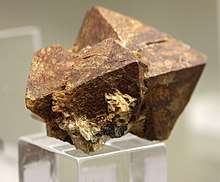
Terbium is occurs with other rare earth elements in many minerals, including monazite ((Ce,La,Th,Nd,Y)PO4 with up to 0.03% terbium), xenotime (YPO4) and euxenite ((Y,Ca,Er,La,Ce,U,Th)(Nb,Ta,Ti)2O6 with 1% or more terbium). The crust abundance of terbium is estimated as 1.2 mg/kg.[27] No terbium-dominant mineral has yet been found.[48]
Currently, the richest commercial sources of terbium are the ion-adsorption clays of southern China;[49] the concentrates with about two-thirds yttrium oxide by weight have about 1% terbia. Small amounts of terbium occur in bastnäsite and monazite; when these are processed by solvent extraction to recover the valuable heavy lanthanides as samarium-europium-gadolinium concentrate, terbium is recovered therein. Due to the large volumes of bastnäsite processed relative to the ion-adsorption clays, a significant proportion of the world's terbium supply comes from bastnäsite.[8]
In 2018, a rich terbium supply was discovered off the coast of Japan's Minamitori Island, with the stated supply being "enough to meet the global demand for 420 years".[50]
Production
Crushed terbium-containing minerals are treated with hot concentrated sulfuric acid to produce water-soluble sulfates of rare earths. The acidic filtrates are partially neutralized with caustic soda to pH 3–4. Thorium precipitates out of solution as hydroxide and is removed. The solution is treated with ammonium oxalate to convert rare earths into their insoluble oxalates. The oxalates are decomposed to oxides by heating. The oxides are dissolved in nitric acid that excludes one of the main components, cerium, whose oxide is insoluble in HNO3. Terbium is separated as a double salt with ammonium nitrate by crystallization.[27]
The most efficient separation routine for terbium salt from the rare-earth salt solution is ion exchange. In this process, rare-earth ions are sorbed onto suitable ion-exchange resin by exchange with hydrogen, ammonium or cupric ions present in the resin. The rare earth ions are then selectively washed out by suitable complexing agents. As with other rare earths, terbium metal is produced by reducing the anhydrous chloride or fluoride with calcium metal. Calcium and tantalum impurities can be removed by vacuum remelting, distillation, amalgam formation or zone melting.[27][41]
In 2020, the annual demand for terbium was estimated at 340 tonnes (750,000 lb).[49] Terbium is not distinguished from other rare earths in the United States Geological Survey's Mineral Commodity Summaries, which in 2024 estimated the global reserves of rare earth minerals at 110,000,000 tonnes (2.4×1011 lb).[51]
Applications
Terbium is used as a dopant in calcium fluoride, calcium tungstate, and strontium molybdate, materials that are used in solid-state devices, and as a crystal stabilizer of fuel cells which operate at elevated temperatures, together with ZrO2.[8][52]
Terbium is also used in alloys and in the production of electronic devices. As a component of Terfenol-D, terbium is used in actuators, in naval sonar systems, sensors, and other magnetomechanical devices. Terfenol-D is a terbium alloy that expands or contracts in the presence of a magnetic field.[53] It has the highest magnetostriction of any alloy.[54] It is used to increase verdet constant in long-distance fiber optic communication.[55][56] Terbium-doped garnets are also used in optical isolators, which prevents reflected light from traveling back along the optical fiber.[57]
Terbium oxides are used in green phosphors in fluorescent lamps, color TV tubes,[8] and flat screen monitors.[58] Terbium, along with all other lanthanides except lanthanum and lutetium, is luminescent in the 3+ oxidation state.[59] The brilliant fluorescence allows terbium to be used as a probe in biochemistry, where it somewhat resembles calcium in its behavior. Terbium "green" phosphors (which fluoresce a brilliant lemon-yellow) are combined with divalent europium blue phosphors and trivalent europium red phosphors to provide trichromatic lighting, which is by far the largest consumer of the world's terbium supply. Trichromatic lighting provides much higher light output for a given amount of electrical energy than does incandescent lighting.[8]
In 2023, terbium compounds were used to create a lattice with a single iron atom that was then examined by synchrotron x-ray beam. This was the first successful attempt to characterize a single atom at sub-atomic levels.[60]
Safety
Terbium, along with many of the other rare earth elements, is poorly studied in terms of its toxicology and environmental impacts. Few health-based guidance values for safe exposure to terbium are available.[61] No values are established in the United States by the Occupational Safety and Health Administration or American Conference of Governmental Industrial Hygienists at which terbium exposure becomes hazardous, and it is not considered a hazardous substance under the Globally Harmonized System of Classification and Labelling of Chemicals.[62]
Reviews of the toxicity of the rare earth elements place terbium and its compounds as "of low to moderately toxicity", remarking on the lack of detailed studies on their hazards[63] and the lack of market demand forestalling evidence of toxicity.[64]
Some studies demonstrate environmental accumulation of terbium as hazardous to fish and plants.[65][66] High exposures of terbium may enhance the toxicity of other substances causing endocytosis in plant cells.[67]
See also
- Terbium compounds
- List of elements facing shortage
References
- ↑ "Standard Atomic Weights: Terbium". CIAAW. 2021.
- ↑ Prohaska, Thomas; Irrgeher, Johanna; Benefield, Jacqueline; Böhlke, John K.; Chesson, Lesley A.; Coplen, Tyler B.; Ding, Tiping; Dunn, Philip J. H.; Gröning, Manfred; Holden, Norman E.; Meijer, Harro A. J. (2022-05-04). "Standard atomic weights of the elements 2021 (IUPAC Technical Report)". Pure and Applied Chemistry. doi:10.1515/pac-2019-0603. ISSN 1365-3075.
- 1 2 Arblaster, John W. (2018). Selected Values of the Crystallographic Properties of Elements. Materials Park, Ohio: ASM International. ISBN 978-1-62708-155-9.
- ↑ Yttrium and all lanthanides except Ce and Pm have been observed in the oxidation state 0 in bis(1,3,5-tri-t-butylbenzene) complexes, see Cloke, F. Geoffrey N. (1993). "Zero Oxidation State Compounds of Scandium, Yttrium, and the Lanthanides". Chem. Soc. Rev. 22: 17–24. doi:10.1039/CS9932200017. and Arnold, Polly L.; Petrukhina, Marina A.; Bochenkov, Vladimir E.; Shabatina, Tatyana I.; Zagorskii, Vyacheslav V.; Cloke (2003-12-15). "Arene complexation of Sm, Eu, Tm and Yb atoms: a variable temperature spectroscopic investigation". Journal of Organometallic Chemistry. 688 (1–2): 49–55. doi:10.1016/j.jorganchem.2003.08.028.
- ↑ La(I), Pr(I), Tb(I), Tm(I), and Yb(I) have been observed in MB8− clusters; see Li, Wan-Lu; Chen, Teng-Teng; Chen, Wei-Jia; Li, Jun; Wang, Lai-Sheng (2021). "Monovalent lanthanide(I) in borozene complexes". Nature Communications. 12 (1): 6467. doi:10.1038/s41467-021-26785-9. PMC 8578558. PMID 34753931.
- ↑ Weast, Robert (1984). CRC, Handbook of Chemistry and Physics. Boca Raton, Florida: Chemical Rubber Company Publishing. pp. E110. ISBN 0-8493-0464-4.
- 1 2 3 4 5 Kondev, F. G.; Wang, M.; Huang, W. J.; Naimi, S.; Audi, G. (2021). "The NUBASE2020 evaluation of nuclear properties" (PDF). Chinese Physics C. 45 (3): 030001. doi:10.1088/1674-1137/abddae.
- 1 2 3 4 5 6 7 Hammond, C. R. (2005). "The Elements". In Lide, D. R. (ed.). CRC Handbook of Chemistry and Physics (86th ed.). Boca Raton (FL): CRC Press. ISBN 978-0-8493-0486-6.
- ↑ "Rare-Earth Metal Long Term Air Exposure Test". Retrieved 2009-05-05.
- ↑ V.B. Taxak, R. Kumar, J.K. Makrandi, S.P. Khatkar Displays, 30 (2009), pp. 170–174
- ↑ Shimada, T.; Ohno, Y.; Okazaki, T.; et al. (2004). "Transport properties of C78, C90 and Dy@C82 fullerenes – nanopeapods by field effect transistors". Physica E: Low-dimensional Systems and Nanostructures. 21 (2–4): 1089–1092. Bibcode:2004PhyE...21.1089S. doi:10.1016/j.physe.2003.11.197.
- ↑ Jackson, M. (2000). "Magnetism of Rare Earth" (PDF). The IRM Quarterly. 10 (3): 1.
- 1 2 "Chemical reactions of Terbium". Webelements. Retrieved 2009-06-06.
- ↑ Gruen, D. M.; Koehler, W. C.; Katz, J. J. (April 1951). "Higher Oxides of the Lanthanide Elements: Terbium Dioxide". Journal of the American Chemical Society. 73 (4): 1475–1479. doi:10.1021/ja01148a020.
- ↑ Hobart, D. E.; Samhoun, K.; Young, J. P.; Norvell, V. E.; Mamantov, G.; Peterson, J. R. (1980). "Stabilization of Praseodymium(IV) and Terbium(IV) in Aqueous Carbonate Solution". Inorganic and Nuclear Chemistry Letters. 16 (5): 321–328. doi:10.1016/0020-1650(80)80069-9.
- ↑ Jenkins, T. F.; Woen, D. H; Mohanam, L. N.; Ziller, J. W.; Furche, F.; Evans, W. J. (2018). "Tetramethylcyclopentadienyl Ligands Allow Isolation of Ln(II) Ions across the Lanthanide Series in [K(2.2.2-cryptand)][(C5Me4H)3Ln] Complexes". Organometallics. 141 (21): 3863–3873. doi:10.1021/acs.organomet.8b00557. S2CID 105379627.
- ↑ Macdonald, M. R.; Bates, J. E.; Ziller, J. W.; Furche, F.; Evans, W. J. (2013). "Completing the Series of +2 Ions for the Lanthanide Elements: Synthesis of Molecular Complexes of Pr2+, Gd2+, Tb2+, and Lu2+". Journal of the American Chemical Society. 135 (21): 9857–9868. doi:10.1021/ja403753j. PMID 23697603.
- ↑ Gould, C. A.; McClain, K. R.; Yu, J. M.; Groshens, T. J.; Furche, F. P.; Harvey, B. G.; Long, J. R. (2019-08-21). "Synthesis and Magnetism of Neutral, Linear Metallocene Complexes of Terbium(II) and Dysprosium(II)". Journal of the American Chemical Society. 141 (33): 12967–12973. doi:10.1021/jacs.9b05816. ISSN 0002-7863. PMID 31375028. S2CID 199388151.
- ↑ Palumbo, C. T.; Zivkovic, I.; Scopelliti, R.; Mazzanti, M. (2019). "Molecular Complex of Tb in the +4 Oxidation State" (PDF). Journal of the American Chemical Society. 141 (25): 9827–9831. doi:10.1021/jacs.9b05337. PMID 31194529. S2CID 189814301.
- ↑ Rice, N. T.; Popov, I. A.; Russo, D. R.; Bacsa, J.; Batista, E. R.; Yang, P.; Telser, J.; La Pierre, H. S. (2019-08-21). "Design, Isolation, and Spectroscopic Analysis of a Tetravalent Terbium Complex". Journal of the American Chemical Society. 141 (33): 13222–13233. doi:10.1021/jacs.9b06622. ISSN 0002-7863. OSTI 1558225. PMID 31352780. S2CID 207197096.
- ↑ Willauer, A. R.; Palumbo, C. T.; Scopelliti, R.; Zivkovic, I.; Douair, I.; Maron, L.; Mazzanti, M. (2020). "Stabilization of the Oxidation State + IV in Siloxide-Supported Terbium Compounds" (PDF). Angewandte Chemie International Edition. 59 (9): 3549–3553. doi:10.1002/anie.201914733. PMID 31840371. S2CID 209385870.
- 1 2 Palumbo, Chad T.; Zivkovic, Ivica; Scopelliti, Rosario; Mazzanti, Marinella (2019-06-26). "Molecular Complex of Tb in the +4 Oxidation State". Journal of the American Chemical Society. 141 (25): 9827–9831. doi:10.1021/jacs.9b05337. ISSN 0002-7863.
- ↑ Greenwood, Norman N.; Earnshaw, Alan (1997). Chemistry of the Elements (2nd ed.). Butterworth-Heinemann. ISBN 978-0-08-037941-8.
- ↑ Cloke, F. Geoffrey N. (1993). "Zero Oxidation State Compounds of Scandium, Yttrium, and the Lanthanides". Chem. Soc. Rev. 22: 17–24. doi:10.1039/CS9932200017.
- ↑ Arnold, Polly L.; Petrukhina, Marina A.; Bochenkov, Vladimir E.; Shabatina, Tatyana I.; Zagorskii, Vyacheslav V.; Cloke (2003-12-15). "Arene complexation of Sm, Eu, Tm and Yb atoms: a variable temperature spectroscopic investigation". Journal of Organometallic Chemistry. 688 (1–2): 49–55. doi:10.1016/j.jorganchem.2003.08.028.
- ↑ Li, Wan-Lu; Chen, Teng-Teng; Chen, Wei-Jia; Li, Jun; Wang, Lai-Sheng (2021). "Monovalent lanthanide(I) in borozene complexes". Nature Communications. 12 (1): 6467. Bibcode:2021NatCo..12.6467L. doi:10.1038/s41467-021-26785-9. PMC 8578558. PMID 34753931.
- 1 2 3 4 Patnaik, Pradyot (2003). Handbook of Inorganic Chemical Compounds. McGraw-Hill. pp. 920–921. ISBN 978-0-07-049439-8. Retrieved 2009-06-06.
- ↑ Cotton (2007). Advanced inorganic chemistry (6th ed.). Wiley-India. p. 1128. ISBN 978-81-265-1338-3.
- ↑ Rau, J. V.; Chilingarov, N. S.; Leskiv, M. S.; Sukhoverkhov, V. F.; Rossi Albertini, V.; Sidorov, L. N. (August 2001). "Transition and rare earth metal fluorides as thermal sources of atomic and molecular fluorine". Le Journal de Physique IV. 11 (PR3): Pr3–109–Pr3-113. doi:10.1051/jp4:2001314.
- ↑ G. Meyer; Lester R. Morss (1991). Synthesis of Lanthanide and Actinide Compounds. Springer Science & Business Media. p. 60. ISBN 978-0-7923-1018-1.
- ↑ Gaumet, V.; Avignant, D. (1997). "Caesium Pentafluoroterbate, CsTbF5". Acta Crystallographica Section C: Crystal Structure Communications. 53 (9): 1176–1178. Bibcode:1997AcCrC..53.1176G. doi:10.1107/S0108270197005556.
- ↑ Largeau, E.; El-Ghozzi, M.; Métin, J.; Avignant, D. (1997). "β-BaTbF6". Acta Crystallographica Section C: Crystal Structure Communications. 53 (5): 530–532. Bibcode:1997AcCrC..53..530L. doi:10.1107/S0108270196014527.
- ↑ "Standard Atomic Weights: Terbium". Commission on Isotopic Abundances and Atomic Weights. 2021.
- 1 2 Wang, Meng; Huang, W.J.; Kondev, F.G.; Audi, G.; Naimi, S. (2021). "The AME 2020 atomic mass evaluation (II). Tables, graphs and references". Chinese Physics C. 45 (3): 030003. doi:10.1088/1674-1137/abddaf.
- ↑ Müller, Cristina; Vermeulen, Christiaan; Köster, Ulli; Johnston, Karl; Türler, Andreas; Schibli, Roger; van der Meulen, Nicholas P. (2016-03-28). "Alpha-PET with terbium-149: evidence and perspectives for radiotheragnostics". EJNMMI Radiopharmacy and Chemistry. 1 (1). Springer Science and Business Media LLC: 5. doi:10.1186/s41181-016-0008-2. ISSN 2365-421X. PMC 5843804. PMID 29564382.
- ↑ Eychenne, Romain; Chérel, Michel; Haddad, Férid; Guérard, François; Gestin, Jean-François (2021-06-18). "Overview of the Most Promising Radionuclides for Targeted Alpha Therapy: The "Hopeful Eight"". Pharmaceutics. 13 (6). MDPI AG: 906. doi:10.3390/pharmaceutics13060906. ISSN 1999-4923. PMC 8234975. PMID 34207408.
- 1 2 Marshall, James L. Marshall; Marshall, Virginia R. Marshall (2015). "Rediscovery of the elements: The Rare Earths–The Beginnings" (PDF). The Hexagon: 41–45. Retrieved 30 December 2019.
- ↑ Marshall, James L. Marshall; Marshall, Virginia R. Marshall (2015). "Rediscovery of the elements: The Rare Earths–The Confusing Years" (PDF). The Hexagon: 72–77. Retrieved 30 December 2019.
- 1 2 3
- Weeks, Mary Elvira (1932). "The discovery of the elements: XVI. The rare earth elements". Journal of Chemical Education. 9 (10): 1751–1773. Bibcode:1932JChEd...9.1751W. doi:10.1021/ed009p1751.
- Weeks, Mary Elvira (1956). The discovery of the elements (6th ed.). Easton, PA: Journal of Chemical Education. pp. 705–706.
- ↑ Marshall, James L.; Marshall, Virginia R. (October 31, 2014). "Northern Scandinavia: An Elemental Treasure Trove". Science history: a traveler's guide. Vol. 1179. ACS Symposium Series. pp. 209–257. doi:10.1021/bk-2014-1179.ch011. ISBN 978-0-8412-3020-0.
- 1 2 3 Gupta, C. K.; Krishnamurthy, Nagaiyar (2004). Extractive metallurgy of rare earths. CRC Press. p. 5. ISBN 978-0-415-33340-5.
- ↑ Eberhard, G. (1906). "A Spectroscopic Investigation of Dr. G. Urbain's Preparations of Terbium". Astrophysical Journal. 24 (5): 309. Bibcode:1906ApJ....24..309E.
- ↑ Stubblefield, C. T.; Eick, H.; Eyring, L. (August 1956). "Terbium Oxides. II. The Heats of Formation of Several Oxides 1". Journal of the American Chemical Society. 78 (16): 3877–3879. doi:10.1021/ja01597a005. ISSN 0002-7863.
- 1 2 Watts, Henry (1881). A Dictionary of Chemistry and the Allied Branches of Other Sciences. Longmans, Green, and Company. p. 2155.
- ↑ Voncken 2016, p. 10-11.
- ↑ James, C.; Bissel, D. W. (June 4, 1914). "Terbium". Journal of the American Chemical Society. American Chemical Society. p. 2062.
- ↑ Bünzli, Jean-Claude G.; Mcgill, Ian (2003-03-11). "Rare Earth Elements". Ullmann's Encyclopedia of Industrial Chemistry (1 ed.). Wiley. doi:10.1002/14356007.a22_607.pub2. ISBN 978-3-527-30385-4.
- ↑ Attia, Yosry A. (October 1990). "Extraction and Refining of High Purity Terbium Metal From Rare Earth Resources". Mineral Processing and Extractive Metallurgy Review. 7 (2): 95–114. doi:10.1080/08827509008952668. ISSN 0882-7508.
- 1 2 Gao, Cuixia; Xu, Yufei; Geng, Yong; Xiao, Shijiang (2022-12-01). "Uncovering terbium metabolism in China: A dynamic material flow analysis". Resources Policy. 79: 103017. doi:10.1016/j.resourpol.2022.103017. ISSN 0301-4207.
- ↑ Takaya, Yutaro; Yasukawa, Kazutaka; Kawasaki, Takehiro; et al. (2018-04-10). "The tremendous potential of deep-sea mud as a source of rare-earth elements". Scientific Reports. 8 (1): 5763. Bibcode:2018NatSR...8.5763T. doi:10.1038/s41598-018-23948-5. ISSN 2045-2322. PMC 5893572. PMID 29636486.
- ↑ "Rare Earths" (PDF). Mineral Commodity Summaries: 144–145. January 2024 – via U. S. Geological Survey.
- ↑ Voncken 2016, p. 101.
- ↑ Deng, Geng (January 2018). "Terbium glows green". Nature Chemistry. 10 (1): 110. doi:10.1038/nchem.2914. ISSN 1755-4349.
- ↑ Rodriguez, C; Rodriguez, M.; Orue, I.; Vilas, J.; Barandiaran, J.; Gubieda, M.; Leon, L. (2009). "New elastomer–Terfenol-D magnetostrictive composites". Sensors and Actuators A: Physical. 149 (2): 251. Bibcode:2009SeAcA.149..251R. doi:10.1016/j.sna.2008.11.026.
- ↑ Loewen, Eric. "Terbium Uses in Electronics". Stanford Advanced Materials. Retrieved Aug 25, 2024.
- ↑ Sun, L.; Jiang, S. (2010). "Compact all-fiber optical Faraday components using 65-wt%-terbium–doped fiber with a record Verdet constant of −32 rad/(Tm)". Optics Express. 18 (12): 12191–12196. doi:10.1364/OE.18.012191.
- ↑ Geho, Mikio; Takagi, Takashi (2005). "Development of Optical Isolators for Visible Light Using Terbium Aluminum Garnet (Tb3Al5O12) Single Crystals". Japanese Jurnal of Applied Physics. 44 (7R): 4967. doi:10.1143/JJAP.44.4967.
- ↑ Voncken 2016, p. 100.
- ↑ Hänninen, Pekka; Härmä, Harri (2011-06-21). Lanthanide Luminescence: Photophysical, Analytical and Biological Aspects. Springer Science & Business Media. pp. 15–20. ISBN 978-3-642-21023-5.
- ↑ Ajayi, Tolulope M.; Shirato, Nozomi; Rojas, Tomas; Wieghold, Sarah; Cheng, Xinyue; Latt, Kyaw Zin; Trainer, Daniel J.; Dandu, Naveen K.; Li, Yiming; Premarathna, Sineth; Sarkar, Sanjoy; Rosenmann, Daniel; Liu, Yuzi; Kyritsakas, Nathalie; Wang, Shaoze (June 2023). "Characterization of just one atom using synchrotron X-rays". Nature. 618 (7963): 69–73. Bibcode:2023Natur.618...69A. doi:10.1038/s41586-023-06011-w. ISSN 1476-4687. PMID 37259001. S2CID 258992110.
- ↑ Kowalczyk, Ewelina; Givelet, Lucas; Amlund, Heidi; Sloth, Jens Jørgen; Hansen, Max (May 2022). "Risk assessment of rare earth elements, antimony, barium, boron, lithium, tellurium, thallium and vanadium in teas". EFSA Journal. 20 (Suppl 1): e200410. doi:10.2903/j.efsa.2022.e200410. PMC 9131585. PMID 35634564.
- ↑ "Terbium Safety Data Sheet" (PDF). Ames Laboratory, U. S. Department of Energy. January 26, 2016. Retrieved August 25, 2024.
- ↑ Rim, Kyung Taek; Koo, Kwon Ho; Park, Jung Sun (March 2013). "Toxicological Evaluations of Rare Earths and Their Health Impacts to Workers: A Literature Review". Safety and Health at Work. 4 (1): 12–26. doi:10.5491/SHAW.2013.4.1.12. PMC 3601293. PMID 23516020.
- ↑ Chen, Haibin; Chen, Zhibiao; Chen, Zhiqiang; Ou, Xiaolin; Chen, Junjia (May 2020). "Calculation of Toxicity Coefficient of Potential Ecological Risk Assessment of Rare Earth Elements". Bulletin of Environmental Contamination and Toxicology. 104 (5): 582–587. doi:10.1007/s00128-020-02840-x. ISSN 0007-4861.
- ↑ Hanana, Houda; Taranu, Zofia E.; Turcotte, Patrice; Gagnon, Christian; Kowalczyk, Joanna; Gagné, François (2021-07-10). "Sublethal effects of terbium and praseodymium in juvenile rainbow trout". Science of the Total Environment. 777: 146042. doi:10.1016/j.scitotenv.2021.146042. ISSN 0048-9697.
- ↑ Sturla Lompré, Julieta; Moleiro, Pedro; De Marchi, Lucia; Soares, Amadeu M. V. M.; Pretti, Carlo; Chielini, Federica; Pereira, Eduarda; Freitas, Rosa (2021-08-25). "Bioaccumulation and ecotoxicological responses of clams exposed to terbium and carbon nanotubes: Comparison between native (Ruditapes decussatus) and invasive (Ruditapes philippinarum) species". Science of the Total Environment. 784: 146914. doi:10.1016/j.scitotenv.2021.146914. ISSN 0048-9697.
- ↑ Cheng, Mengzhu; Zhou, Qing; Wang, Lihong; Jiao, Yunlong; Liu, Yongqiang; Tan, Li; Zhu, Hong; Nagawa, Shingo; Wei, Haiyan; Yang, Zhenbiao; Yang, Qing; Huang, Xiaohua (2022-01-05). "A new mechanism by which environmental hazardous substances enhance their toxicities to plants". Journal of Hazardous Materials. 421: 126802. doi:10.1016/j.jhazmat.2021.126802. ISSN 0304-3894.
Bibliography
- Voncken, J.H.L. (2016). The Rare Earth Elements: An Introduction. SpringerBriefs in Earth Sciences (1st ed.). Cham : Springer International Publishing. doi:10.1007/978-3-319-26809-5. ISBN 978-3-319-26809-5.